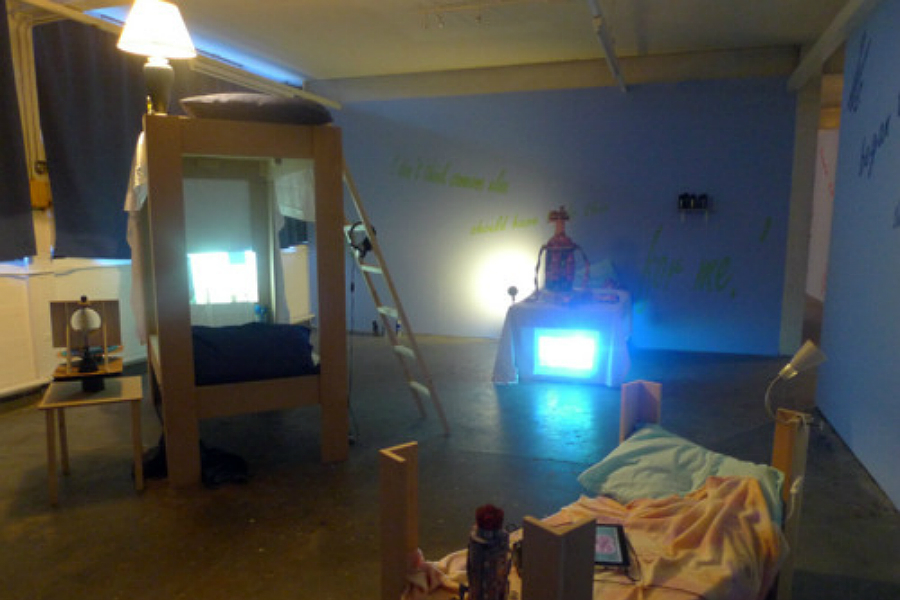My Five New Friends – Reviewed

Linda Pitwood on an exhibition blurring the lines between Facebook friends, stalkers, and stalkees….
There are, in effect, two exhibitions currently showing in The Royal Standard’s unheated but perfectly formed gallery space. One is My Five New Friends, curated by It’s Our Playground, a French duo who consider exhibition production to be their artistic practise. The other being an exhibition within the exhibition, of Oliver Braid’s hand-made sculptural objects; the plinths on which the objects sit are made to look like beds and so integrate the sculptures into an installation based on a teenage boy’s bedroom, and into a conceptual narrative that exists beyond the confines of the gallery walls.
The origins of My Five New Friends go back to Braid’s post-graduate degree show at Glasgow School of Art in 2010. Braid produced pencil drawings from images of the five males he found most attractive and wanted to befriend. The source of these images was the ubiquitous social networking site Facebook, and Braid had taken these photographs without asking. The first time the subjects learned what he had done was on seeing the drawings at the show. The process of Braid trying to befriend these men is documented through diary entries published on the website myfivenewfriends.com, which has been made public to coincide with the opening of this show. The idea of images being stolen gives the exhibition a dark twist, which may put off some visitors, but attract others. There is an ethical question here: even though you can acquire images in this way, does that make it okay? And one other question arises: if Braid had done this to you, would you be his friend?
In It’s Our Playground’s exhibition are works by six other artists chosen by Braid to respond to the diaries he kept while trying to befriend the five men. The exhibition has high sensory impact; the walls are light blue, painted with quotations from the diaries in gold and pink, the smell of lynx hangs in the air and catches visitors in the lungs. Of the six artists besides Braid in the show, five have produced videos and four of these project their audio tracks into the gallery where they compete with one another. The only intimate audio/visual experience is the film I’m not perfect but I’m perfect for you, by Roxy Topia and Paddy Gould, who have animated the recital of their wedding vows, including the lines: “I will be the Gilbert to your George… I will photograph, Photoshop and photomontage at your request.” These vows, in keeping with the collaborative spirit of the show, where written by Braid.
The other videos include Braid as an animated drawing, two DJs advising Braid on his sexuality and a face-to-camera by performance artist and director David Hoyle. Some of the artists stick to the remit of analysing Braid and his processes more closely than others. For those wanting deeper analysis, an extended essay by one of the men who was a target of Braid’s affections, Alex Misick, is produced as a limited edition publication. There is also a foreword in the exhibition leaflet by Braid’s friend and housemate Ellie Harrison. The leaflet, and Misick’s publication add another layer to the adolescent visual vocabulary, employing images of teen drama Skins, and the pop group The Backstreet Boys.
My companion asked whether the objects could exist without the conceptual narrative, and whether the narrative could exist without the objects? This is something to muse on while enjoying Braid’s fabulous sculptures. One object is placed on each ‘bed’. All of the sculptures have a fantastic textured surface made of craft-foam, sequins, shells, embroidery and drawings. Look out for the hand-made miniature Sylvia Plath novels on A pig boat with enormous balls is a desk toy, and the ten pound note peaking out of the money box entitled, I’m 26 and I’ve Got Nothing. The connection between the objects and the narrative is not clearly communicated. It is possible that Braid would have sat at home during his adolescence making objects such as these, rather than developing conventional relationships and social skills; however, beyond this link they seem to be a totally separate body of work.
It’s Our Playground have succeeded in producing a highly-original exhibition, exploring the teenage crush, obsession and relationships at the beginning of the 21st century. This exhibition brings to mind the ouroboros symbol of a snake eating its own tail, or the episode of the Simpsons where Homer gets sucked into the computer and becomes pixellated. When at home reading the diary entries, or looking at Braid’s social networking profiles, the viewer and Braid become characters in a story with endless possibilities; however it is the objects that are the stars of this show and the exhibition is worth visiting for these alone.
Linda Pitwood
Exhibition continues @ The Royal Standard until 3rd March





